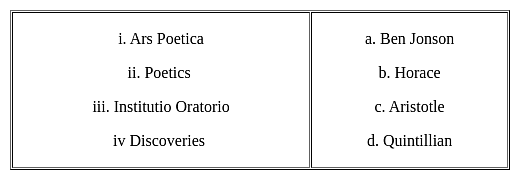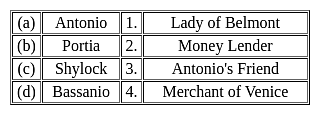APSET Paper 2 Mock Test - 4 (English) - AP TET MCQ
30 Questions MCQ Test - APSET Paper 2 Mock Test - 4 (English)
In the works of which of the following theorists, the concept of reification rose to prominence?
Which concept, introduced by Julia Kristeva, explores the pre-symbolic stage of development, focusing on the relationship between a mother and her child?
| 1 Crore+ students have signed up on EduRev. Have you? Download the App |
Samuel Beckett’s trilogy published together in London in 1959 under the English titles is
Match the following works with their authors:

The Bhasmasura myth is used in R. K. Narayan’s ________.
The island setting of Latmos figures in Keats’s
In The Rape of the Lock Pope repeatedly compares Belinda to
Match the following writers and their works:

By which of the following names does Volpone refer to his treasure (his money) in Act I, scene I ?
William Wordsworth 's statement of purpose in publishing the Lyrical Ballads carries the following phrases. ( Complete the phrase correctly). " to choose incidents from common life and to relate or describe them, throughout, as far as possible, ____."
The error of interpreting a literary work by referring to evidence outside of itself, such as the design and purpose of the author is called __________.
Identify the statement that is NOT TRUE among those that explain "stage directions" in drama.
"Great wits are sure to madness near allied
And thin partitions do their bounds divide". The above lines appear in...



















